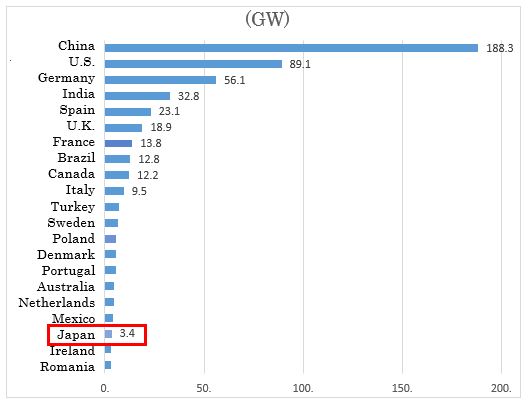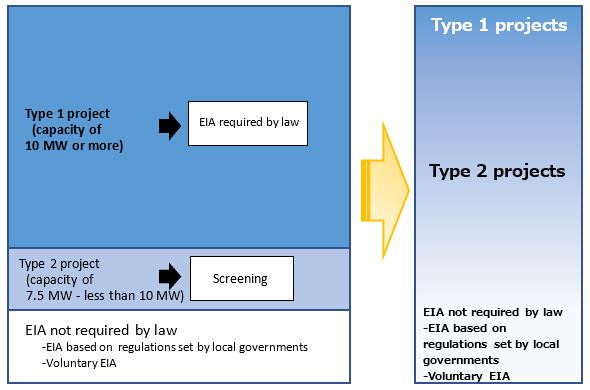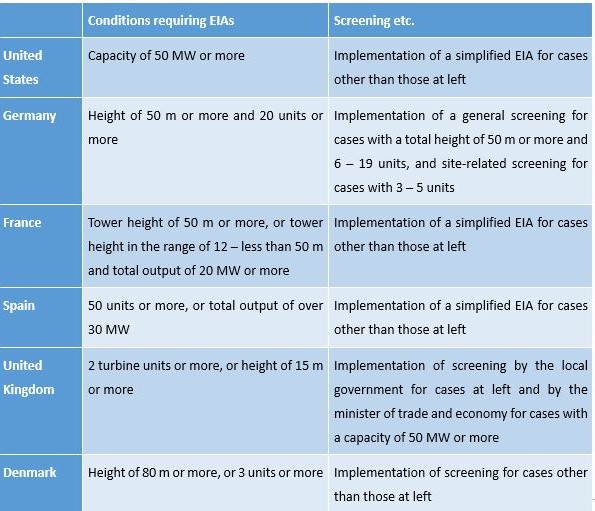On 17 January 2019, the Japanese Ministry of the Environment prepared a draft proposal on the application of Environmental Impact Assessment (EIA) for renewable energy projects. The draft indicates the scale requirement for large-scale solar power generation projects for which EIA must be performed (40 MW) based on the Environmental Impact Assessment Acti.
There were also discussions on relaxing wind power generation’s scale requirement for EIA, which Renewable Energy Institute has been pointing out, but the idea has been shelved. At present, the scale subject to EIA for wind power generation is 10 MW or more, which, compared to 150 MW of scale for domestic coal-fired thermal power plants and 50 MW for wind generation in other countries, poses difficult circumstances for Japanese wind projects. This column comments on the discussions concerning the scale for wind power EIAs.
Onshore Wind Power Generation Remains Stagnant in Japan
Japan’s wind power has a capacity of approximately 3.6 GW as of March 31, 2018ii. In contrast to photovoltaic systems which have shown rapid expansion since the introduction of the feed-in tariff (FiT) scheme, wind power only increased its capacity by less than 1 GW during five years between FY2012 and FY2017. In fact, the pace of growth has slowed down compared to the five years period before the start of FiT when as much as approximately 1.5 GW of wind power had been introducediii. Meanwhile, the worldwide capacity of wind has already reached approximately 539 GWivas a result of expanded investment that brought about decline in costs, gaining momentum. In Europe, there is extensive replacement of old turbines that were installed in the 1990s, and installation of offshore wind farms has begun to expand in earnest.
Source: Prepared by the Renewable Energy Institute based on "Global Wind Report 2017," Global Wind Energy Council (2018).
The major factor behind the low penetration of wind power in Japan lies in grid constraints, but one that had particular impact since FiT was introduced may be the environmental impact assessment (EIA). The abolition of subsidies for the installation of wind power facility in 2011 had forced wind power projects to be suspended for 2011 and 2012 amid the uncertainty over FiT introduction itself and price levels. Having been introduced under such circumstances, EIA has further prolonged the time for development.
EIA measures the impact of projects on the natural environment including plants, animals and eco-systems, as well as our living environment such as scenery and noise levels. They also function as an important process for deepening communication with the relevant local communities. On the other hand, the implementation of a comprehensive assessment to all projects leads to an increase in costs, imposing heavier burden on society overall as a result. For this reason, the law set the requirement that "projects that may become larger in scale and have a marked environmental impact" to be subject to EIA.
When determining the current scale of wind power facilities subject to EIA requirement, the scale of wind generators that had been conducting EIA voluntarily and the areas of land modified from 10 MW geothermal plant and 150 MW thermal plant, both of which had been subject to EIA in advance, were also referenced. Accordingly, EIA has become mandatory for wind facilities with a capacity of 10 MW or more, which accounted for 84 percent of total wind projectsv.
The capacity of wind turbines was approximately 2 MW per unit in 2012, which now ranges from 3 to 4 MW. Because of the necessity for wind generation facilities to grow in size to produce power more efficiently with low-speed wind, there are increasing number of projects with a capacity of 10 MW or more per site. Among the projects that have been planned after the implementation of law-based EIA, 98.6 percent were subject to EIA processvi. Avoiding the assessment meant reducing the number of wind turbines, which would result in higher project costs.
Postponement of Proposal for Revising Scale Requirement and Utilization of Screening System
Meanwhile, wind power generation has different characteristics from other generation facilities and requires much space as compared to the land area it occupies. When installing several wind turbines, there must be a certain distance between turbines, making the project site become larger but the area that needs alteration be smaller. Therefore, it is not rational to determine the EIA requirements in the same mindset as for the other types of power generation (i.e. thermal, geothermal and solar), where extensive area of land alteration would be needed to install generation facilities on the area.Considering such characteristics, the relaxation of the scale criterion of wind power was discussed once, but ended up being shelved. This was due to lack of data on environmental impact after the start of operation of wind generators, which consequently put higher priority on addressing concerns of not being able to measure environmental impact by easing scale requirements.
In addition, nonetheless, the draft proposal pointed out that "it was suggested that the extent of environmental impact of wind power projects varies not in the scale but in site conditions." It proposed, therefore, expanding utilization of screening system because the "classification of the extent of environmental impact by scale alone is not necessarily a rational approach." Screening is a system to identify whether EIA is needed or not by examining the specific conditions of projects including those that are not subject to EIA based on scale criterion. The aim is "to enable to perform necessary EIA continuously for projects that are deemed to have greater environmental impact by their site conditions while reducing undue burden for operators through the scale criterion relaxation.” In other words, projects that are obliged to perform full-featured EIA will be limited to those of a certain size but those of smaller size will also be subject to EIA under certain conditions. This allows more flexibility in the system thus favorable feedback can be expected.

Source: Renewable Energy Institute
There are also needs for the accumulation and sharing of environmental impact related data, which, at the same time, can be useful in setting the ‘zoning.’ Zoning is a measure to clarify the suitable site and the area that needs environmental protection and promote introduction of renewable energy. Its validity has already been pointed out, as included in the draft proposal. Zoning has already been implemented by several local governments and is expected to spread in a manner that can satisfy both the introduction of renewable energy and the conservation of the natural environment.
Setting scale requirement for EIA is an important and challenging issue that needs a proper balance between pursuit of policy objectives, promotion of projects and environmental impacts. This is clear from the trends where many small-scale coal-fired thermal power stations have been built on a just a little smaller scale of the threshold requiring EIA in order to avoid it.
The year 2022 will mark the 10th anniversary of the current law’s enactment, and there will be opporunities to revise the law. In order to prevent a further deferral of the revision for the lack of data, it is hoped that concrete action plans for the revision will be developed to advance discussions for the next few years.

Source: Created by Renewable Energy Institute based on the Ministry of the Environment material (noted below) and other sources.
- i "(Draft) Report of the Working Group Regarding Basic Concept on Environmental Impact Assessments Related to Photovoltaic Power Generation Facilities etc." (in Japanese)
- ii "Trend of Installed Wind Power Capacity in Japan," New Energy and Industrial Technology Development Organization (as of March 31, 2018) (in Japanese)
- iii Idem.
- iv "Global Wind Report 2017," Global Wind Energy Council (2018)
- v "Report of the Working Group Regarding Basic Concept on Environmental Impact Assessments Related to Wind Power Generation Facilities," Ministry of the Environment, p. 11 (June 2011) (in Japanese)
- vi Material 2-1 for the 5th Working Group Meeting (prepared by the Japan Wind Power Association), p. 19 (in Japanese)
Reference for Figure 3: Report on Study Related to Addition of Wind Power Generation to the Projects subject to Environmental Impact Assessment Act FY2011, Material 1 for the 5th Study Group Meeting (in Japanese)






